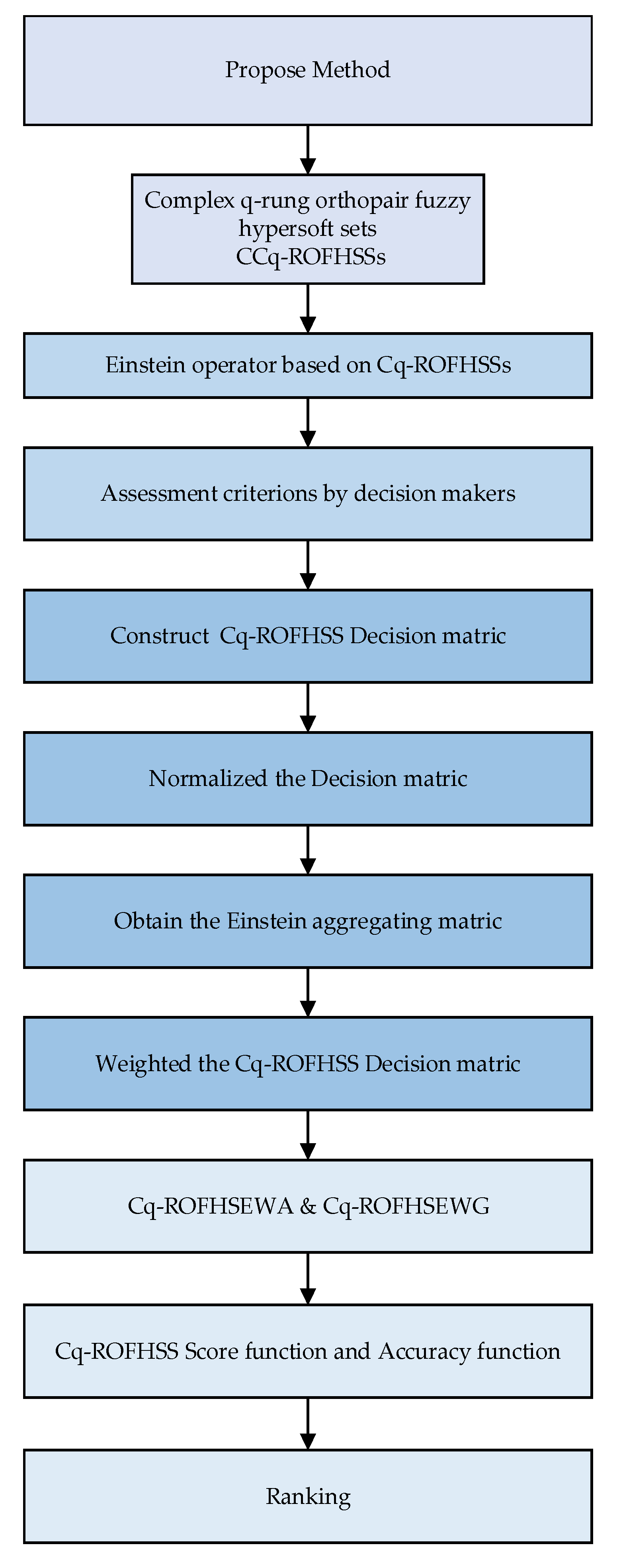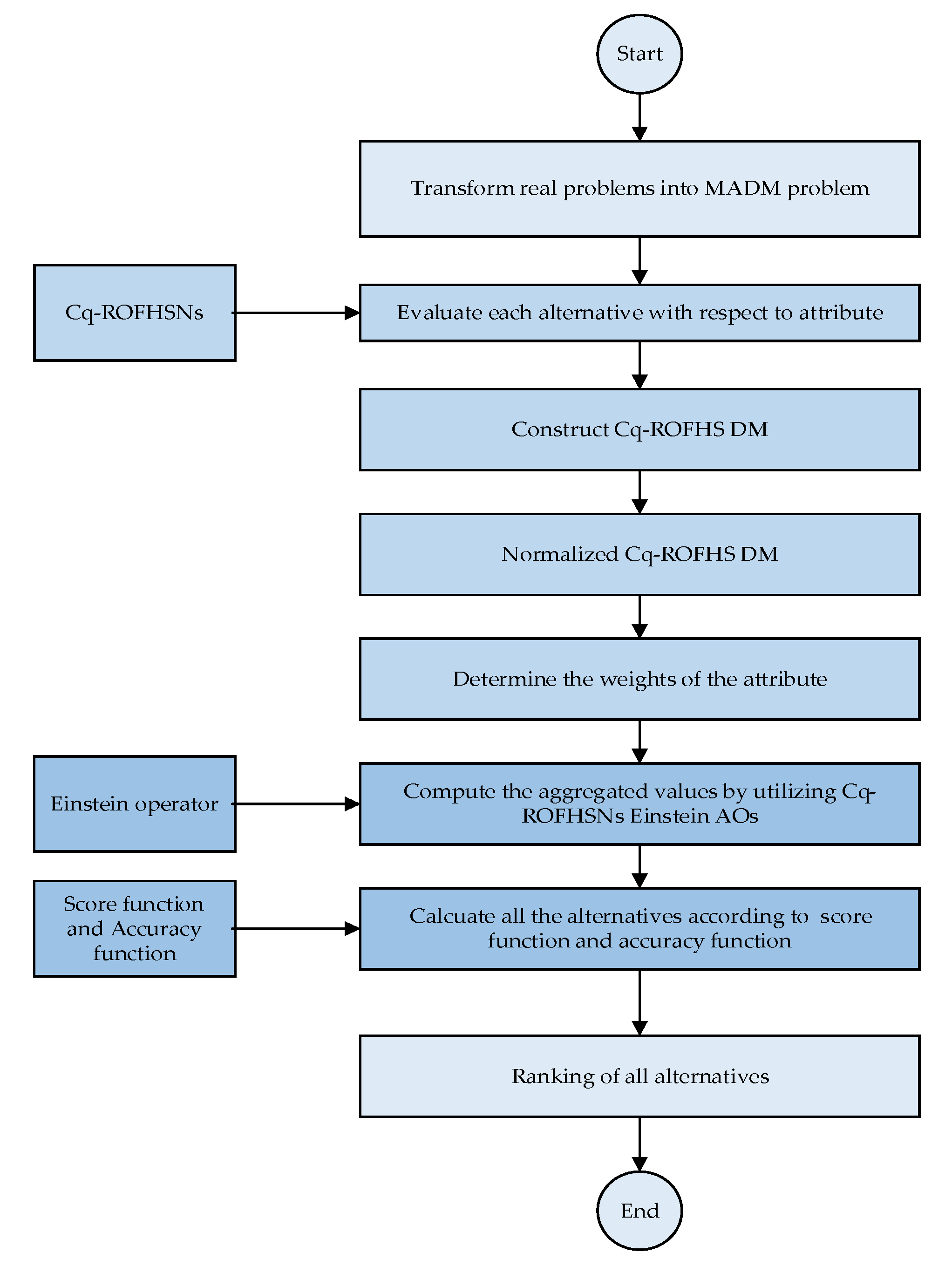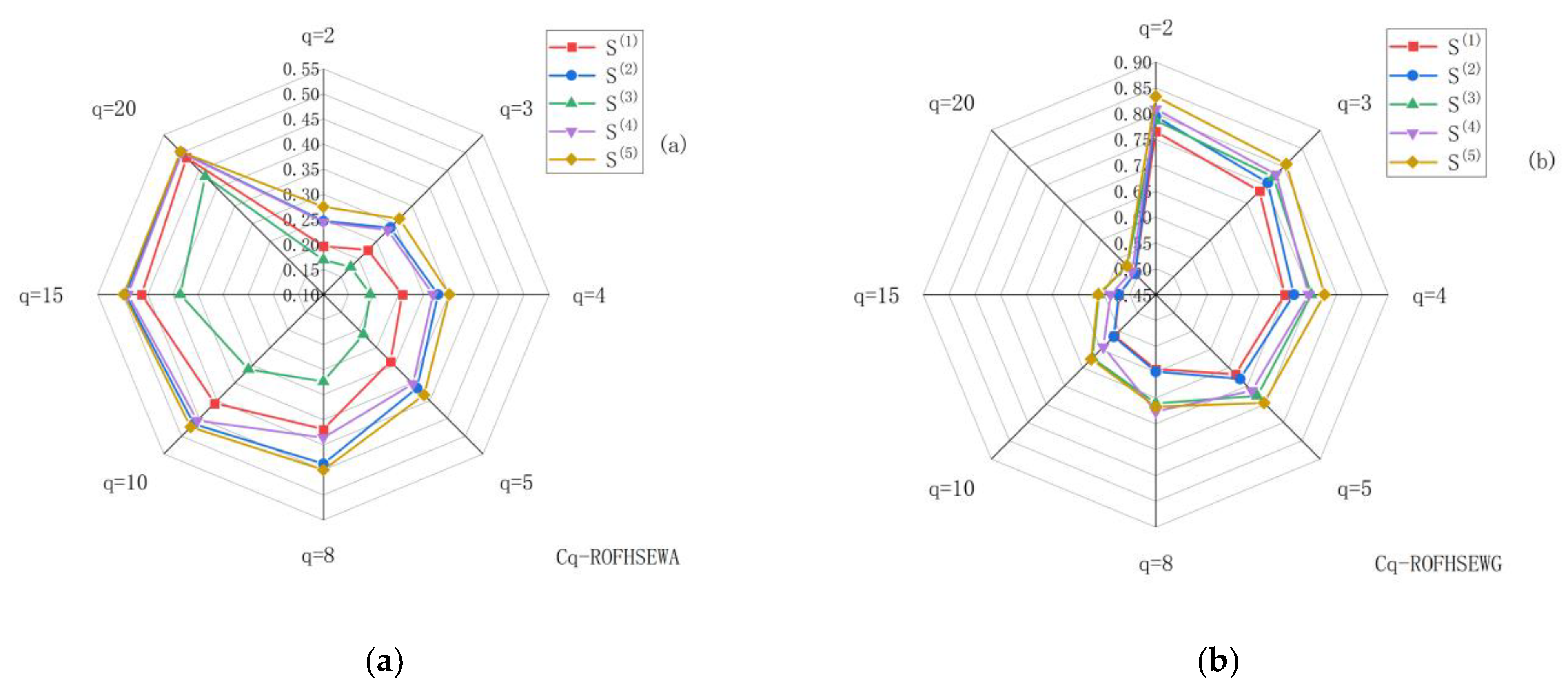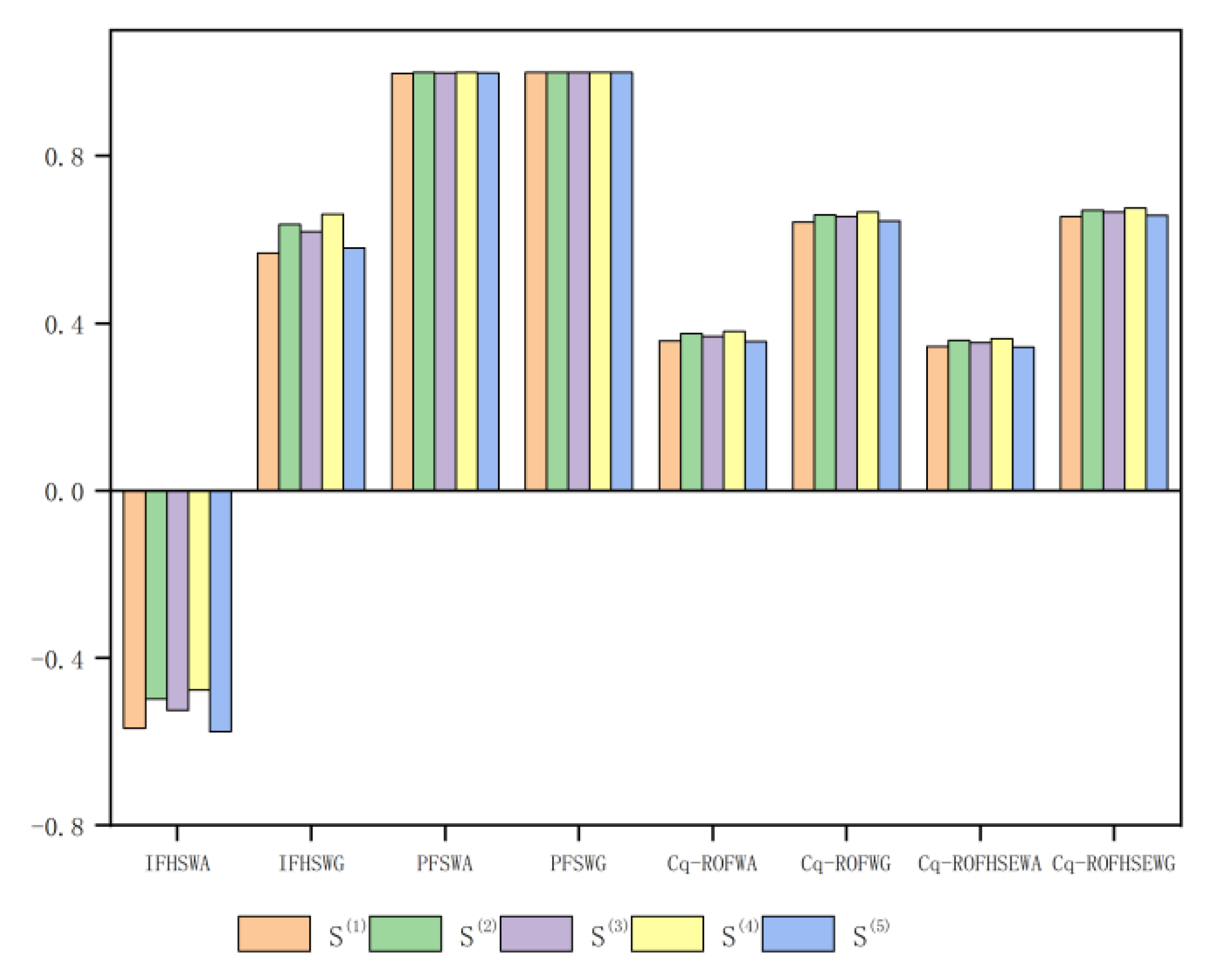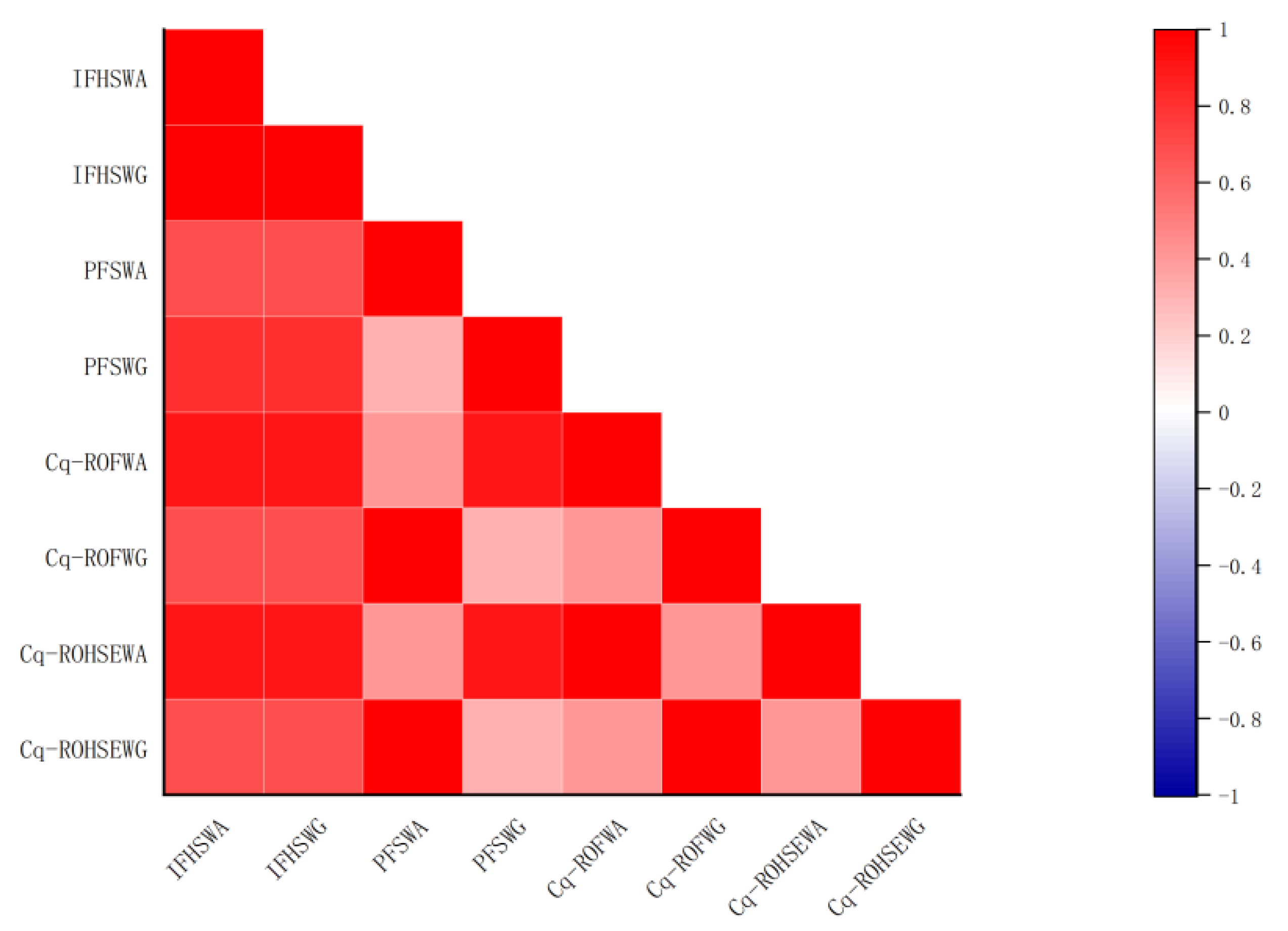1. Introduction
In decision science, multi-attribute decision making (MADM) seeks to determine the best choice under different sets of attributes. There is a growing emphasis on multi-attribute decision-making in decision science, systems engineering, and management science. In addition to its applications in economics, management, engineering, and the military, its theories and methods are widely employed for investment decisions, factory site selection, college evaluation, project bidding, ranking of industrial sector development, and comprehensive economic benefits evaluation. Experts or teams of experts evaluate each alternative according to a variety of attributes, and the results can be expressed in clear numbers or in linguistic terms. In today’s challenging environment, uncertainty plays an important role in almost every decision-making process. Analyses must take uncertainty into account in order to be accurate. According to classical set theory (CST), there are only two possible outcomes for an item: either it belongs to a set, or it does not. An item’s characteristic function can be either 0 or 1. Several factors contribute to the failure of CST, including age, intelligence, and height.
As a solution to this problem, Zadeh [
1] proposed the concept of Fuzzy Sets (FS). In order to solve complex problems involving uncertainty and ambiguity, the degree of membership (Mem) is assigned to the closed interval [0, 1] rather than {0, 1}. As a result, Atanasove’s intuitionistic fuzzy set (IFS) has been demonstrated to be a useful tool for describing uncertainty in MADM [
2]. There are two parameters, Mem and NMem, the sum of which is less than or equal to 1, and it is more general than fuzzy sets (FS). Researchers have developed and used some theories to explain this phenomenon, including interval-valued IFSs [
3] and linguistic interval-valued IFSs [
4]. The above theory indicates that the sum of an individual’s Mem and NMem cannot exceed one. Research has been conducted on MADM problems in the context of FSs and IFSs, which can only be used to address decision makers’ uncertainty and ambiguity. It is important to note, however, that when complex datasets are used, uncertainty and ambiguity often accompany periodic changes in the dataset.
With the advancement of technology over the years, it has become apparent that these and similar methods are inherently limited, and cannot handle information that changes over time, such as medical diagnosis, biometrics, etc. In light of the above surveys, it can be concluded that all of the above studies are based on pairs of real numbers. Ramot et al. [
5] proposed the concept of complex fuzzy sets (CFS), which extend the range of Mem beyond the set of real numbers to the unit disk of the complex plane. For solving MADM problems involving uncertain and complex information, Alkouri and Salleh [
6] proposed Complex Intuitive Fuzzy Sets (CIFS). Complex Mem and complex NMem degrees characterize the CIFSs, where the sum of the real and imaginary parts is less than or equal to one. The prevalence of CIFSs is greater than that of CFSs. There are times when CIFSs can solve problems that CFSs cannot. It extends the range of Mem and NMem levels from real to complex numbers by utilizing a unit disk. In contrast to IFSs, CIFSs have the capability of handling two-dimensional information, which prevents information loss. Kumar and Bajaj [
7] used distance metrics and entropy to develop complex intuitionistic fuzzy soft sets. A series of correlation coefficients and aggregation operators based on CIFS has been proposed by Garg and Rani [
8]. CIFSs have been used by Rani and Garg [
9] to develop a distance metric and a power aggregation operator.
Originally developed by Yager [
10], a Pythagorean fuzzy set (PFS) extends the intuitionistic fuzzy set theory. As PFSs are characterized by Mem and NMem, it provides a more comprehensive and detailed description of the intuitionistic fuzzy features of the data. PFSs assign each element a degree of Mem and a degree of NMem, whose sum of squares cannot exceed 1. In realistic MADM problems, simulating uncertainty with PFSs is clearly superior to simulating uncertainty with IFSs. Ullah et al. [
11] have developed a new framework for describing uncertain or unreliable information, the Complex PFS (CPFS). The CPFS has a complex-valued Mem and a complex-valued NMem, thereby allowing it to describe the complex fuzzy characteristics of the data in a more comprehensive and meticulous manner. In CPFSs, each element is assigned a complex-valued Mem degree and a complex-valued NMem degree whose sum of squares is one. According to CPFSs, the sum of the squares of the real (and imaginary) parts of the complex non-membership degree cannot exceed [0, 1].
In some real decision-making processes, the sum of the squares of the Mem and NMem of alternatives that satisfy the criteria provided by the decision maker may be greater than 1, but their sum of q-power may be equal to or less than one. As such, Yager [
12] proposed a q-rung orthopair fuzzy set (q-ROFS), which is characterized by Mem and NMem degrees meeting the condition that the q-power of Mem and NMem degrees cannot exceed 1. In practical decision-making problems involving uncertain and unpredictable information, the q-ROFS is more effective and general than existing methods. In the case of q = 1 and q = 2, the q-ROFS reduces to an IFS and a PFS, respectively. Thus, IFSs and PFSs can be considered special cases of the q-ROFS. A fuzzy Bonferroni average operator based on q-rung orthopairs has been developed by Liu [
13] and applied to MAGDM. Wei et al. [
14] have proposed a fuzzy heronian mean operator based on q-rung orthopairs. According to Liu and Wang [
15,
16], several fuzzy aggregation operators have been proposed for q-rung orthopairs. The power Maclaurin symmetric mean is also developed to aggregate the interrelationships between q-ROFNs. In [
17], a q-rung orthopair linguistic heronian mean operator (HM) was proposed and applied to MADM. The concept of IVq-ROFS and the IVq-ROF multiple average operators was introduced by Joshi et al. [
18]. Liu et al. [
19] have developed a theory of complex q-rung orthopair fuzzy sets (Cq-ROFS). The Cq-ROFS proposes that the sum of the q-th power of the real (and imaginary) part of the complex Mem degree and the q-th power of the complex NMem degree does not exceed the unit interval. Cq-ROFS is a more general format compared to CIFSs and CPFSs. A Cq-ROFS provides a useful tool for capturing the ambiguity and periodicity in human evaluation semantics in real-world decision theory. Based on aggregation operators, AHP, and TOPSIS, Garg et al. [
20] proposed a complex interval q-rung fuzzy set (CIVq-ROFS). Accordingly, Ali [
21] proposed complex interval-valued q-rung orthopair fuzzy hamy mean operators and their application to decision-making strategies. In contrast to Cq-ROFS, CIVq-ROFS has a broader generalization than Cq-ROFS. All of these methods are widely used in many fields. However, a major common limitation of these theories is that they are not suitable for parametric descriptions. To overcome this complexity, Molodtsov [
22] proposed the pioneering concept of Soft Sets (SS), a general mathematical parameterization tool for dealing with indeterminate, ambiguous, and indeterminate components, where certain specific parameters are evaluated. The ideas of the soft set theory are further combined with other fuzzy mathematical structures to develop new models, such as Fuzzy Soft Sets (FSSs) [
23], Intuitionistic Fuzzy Soft Sets [
24], Pythagorean Fuzzy Soft Sets [
25,
26], and q-Rung orthopair fuzzy soft sets (q-ROFSSs) [
27]. Taken together, they provide a rich and diverse environment for the fuzzy modeling of parametric non-crisp data.
The existing studies, however, do not provide sufficient information regarding Mem and NMem values. However, these theories are not able to handle inconsistencies and imprecise data in general. There is a tendency for popular theories to fail to address this type of problem when an attribute is composed of a number of subattributes. By replacing the single-parameter function f with a multiparameter (sub-attribute) function, Smarandache [
28] developed the concept of SSs to hypersoft sets (HSS). Samarandache argues that the established HSS is capable of handling indeterminate objects in comparison with the established SS. A number of unexpected results have been achieved in recent years as a result of the HSS theory and its extensions. Zulqarnain et al. [
29] therefore proposed the intuitionistic fuzzy hypersoft set IFHSS, a generalized version of IFSS. Using the developed correlation coefficient, they developed the TOPSIS method for solving the MADM problem. The authors then proposed a robust aggregator operator for intuitionistic fuzzy Hypersoft sets [
30] and applied it to the selection of suppliers. Zulqarnain et al. [
31] perform the basic operations as well as their appropriate details under the Pythagorean Fuzzy Hypersoft Set (PFHS). In the context of PFHS sets, they introduce the concepts of demand and possibility operators in their definition of logical operators. Reference [
32] describes the use of soft class and its analogous hypersoft mapping in the diagnosis of various diseases, including brain tumors, hepatitis, and HIV, and suggests appropriate treatments and future warnings. According to Ihsan et al. [
33], the Hypersoft expert set has been applied to the enterprise decision-making recruitment process. In the presence of unpredictable factors, Wang et al. [
34] proposed a fuzzy interactive Einstein dynamic membership function to measure the quality of expressive service. In order to recommend drugs for allergic diseases, Saeed et al. [
35] proposed a Pythagorean fuzzy hypersoft map structure. Zulqarnain [
36] proposed basic operations based on Pythagorean fuzzy hypersoft sets and correlation coefficients. Khan [
37] proposed the q-rung hypersoft set (q-ROFHSS) and described its basic operations. Musa and Asaad [
38] defined logical operators for bipolar hypersoft sets. The concepts of complex fuzzy hypersoft sets (CFHSS) were introduced by Rahman [
39], a decision system based on its decision aggregation operation was developed and applied to decision-making, and the basic theory of interval-valued fuzzy hypersoft sets was studied. Using fuzzy sets and hypersoft sets with complex plane features, the model establishes a hybrid framework. It is possible to extend the features of the fuzzy hypersoft set to the unit circle in a complex plane, making this structure more flexible and useful.
We extend the concept of CFHSS to Cq-ROFHSS in order to address the above problems in a comprehensive manner. In addition, the set’s properties are examined. Based on the proposed Cq-ROFHSS, the sum of the q-powers of the real (imaginary) part of the Mem and the NMem degree must be less than or equal to 1. Through the ensemble, uncertainty and ambiguity are taken into account simultaneously in complex numbers. Moreover, a central component of the multi-criteria decision problem is the aggregation of satisfaction with individual criteria in order to obtain a measure of satisfaction with all criteria. This process of aggregation must be guided by the interrelationship between individual criteria and criteria organizations. The increasing complexity of practical decision problems may necessitate the modeling of these numerous types of relationships when selecting aggregation operators [
40,
41].
This study should investigate the following theories based on the following arguments and evidence:
- (i)
As a result of complex q-ROFS theory, both the uncertainty and periodicity of the source data can be effectively modeled. When the membership function values are extended to the unit circle, a wide range of membership function values is possible. Even though it is an effective tool for parametric descriptions, it has some limitations. Since its inception, the proposed theory has been superior to the Complex q-ROFS model due to its ability to address the parametric ambiguity of two-dimensional fuzzy data.
- (ii)
Q-ROFS contains information about Mem and NMem, but lacks information about complex Mem and complex NMem, therefore relaxing the scope of the Q-ROFS model. In various practical applications, attributes should be further subdivided into sub-attribute values in order to facilitate a better understanding.
- (iii)
An HSS model replaces a single-parameter function with a multiparameter function (sub-attribute); however, it cannot handle other sources of uncertainty. The periodicity of information can be adequately accounted for by a model we developed. For the parametric modeling of periodic and ambiguous data, our proposed Cq-ROFHSS theory provides a more general and constructive framework.
- (iv)
Although CIFHSSs and CPFHSSs have a strong capability to deal with parameter ambiguity in two-dimensional problems, their boundary scope is constrained by some strict restrictions. We are able to capture the inaccuracies arising from parameterized uncertain environments by developing a model that relaxes them. We are able to capture the inaccuracies that are present in some parametric uncertain environments while simultaneously relaxing them.
- (v)
The q-ROFHSS model provides an efficient mathematical structure for resolving uncertainties in parametric datasets as well as uncertainties in linear datasets. However, it is limited to a single dimension. We generalize the q-ROFHSS model by using periodic fuzzy interpretations containing inconsistent information.
Combined with the previous point, these two advantages demonstrate the concept’s generalizability.
The purpose of this paper is to propose a complex q-rung orthopair fuzzy hypersoft set (Cq-ROFHSS) in order to address these issues. Due to the combination of both the complex q-rung orthopair fuzzy set and the outstanding mathematical theory of HSS, the method provides the best of both worlds. The mathematical framework proposed allows the parametric design of periodic and fuzzy data in order to solve multi-attribute decision-making problems. Using the Cq-ROFHSS model, it can express a large number of fuzzy multi-attribute evaluations in two dimensions. Through an adjustable parameter q, it is a robust generalization of CIFHSSs and CPFHSSs. The proposed model is briefly compared with existing competing methods in order to illustrate its remarkable flexibility. In the following section, we describe the Einstein operator of the Cq-ROFHSS as well as a few other elementary algebraic operations. Using the optimal selection and application of distributed control systems, we develop two advanced decision-making algorithms and demonstrate their effectiveness. A clear histogram and Spearman correlation analysis are used to verify the reliability and functionality of the proposed strategy.
The following are a few of the most important contributions of this paper:
- (i)
The purpose of this article is to systematically extend the literature in order to introduce the multi-skill, most generalized mixed model Cq-ROFHSS. A two-dimensional multi-parameter inconsistent data set can be correctly modeled with this method using an ordination-based fuzzy model.
- (ii)
For the purpose of demonstrating the applicability issues of the proposed method, we compare the method proposed in this paper with existing methods for the example of early warning opinion system selection. Based on empirical data obtained from distributed control systems, the rationality and responsibility of the proposed technology have been confirmed.
- (iii)
We present a brief analysis of the MADM method, including the development of a MADM method for Cq-ROFHSSs based on the Einstein aggregation operator and the proposed score function measure. This study examines the sensitivity of the variables involved in the Einstein aggregation operator as well as their impact on the decision results. In this study, we compare and analyze the existing MADM techniques using the IFHWA, IFHWG, PFSWA, PFSWG, and Cq-ROFWA, Cq-ROFWG operators. Thus, it is demonstrated that the strategy proposed in this paper is feasible and that its results are compatible.
- (iv)
As demonstrated in this article, the MADM methodologies exhibit flexibility, capability, and prominence beyond contemporary decision-making methods.
In accordance with this, the remainder of the paper is organized as follows:
Section 2 briefly introduces some key concepts and terminology prior to the discussion of the goal theory. In
Section 3, we present the framework for the proposed Cq-ROFHSS model, as well as basic set-theoretic operations. Additionally, Einstein and other algebraic algorithms are described for the Cq-ROFHSS. Through the application of the proposed operator,
Section 4 presents two decision-making algorithms for the development of Cq-ROFHSSs and illustrates their applicability through the selection of financial evaluations for construction firms. Furthermore,
Section 5 discusses MADM methods, including the proposed MADM method of the Einstein aggregation operator and its feasibility. In this paper, we investigate the impact of the variables involved in the Einstein aggregation operator on the decision-making process as well as their sensitivity. The advantages and disadvantages of the Cq-ROFHSS theory over other contemporary decision-making models are then discussed by conducting a comparative study with existing MADM techniques based on IFHWA, IFHWG, PFSWA, PFSWG, Cq-ROFWA, and Cq-ROFWG. In
Section 6, the article’s conclusion is summarized, and some future research areas are suggested.
As shown in
Figure 1, this research article makes a significant contribution to the field.
2. Preliminaries
In this section, we provide some definitions that will aid in understanding the remainder of the article. We present some basic definitions of the soft set, hypersoft set, complex q-rung orthopair fuzzy set, and complex q-rung orthopair hypersoft fuzzy set, and some operations on them that are well known in the literature.
Definition 1 (see [22]).Letbe the universal set and letbe the set of parameters under consideration. Letdenote the power set ofand. A pairis called a soft set (SS) over, and its mapping is given asA soft set may be represented by the set of ordered pairs asIn other words, the soft set is a parameterized family of subsets of the universe. Definition 2 (see [28]).Letbe the universal set andbe the power set of. Considerforand letbe well-defined attributes, whose corresponding attributive values are, respectively, the setwith, forand. Assumeis a collection of sub-attributes, whereand. Then, the pairis said to be a hypersoft set over, whereis the mapping such thatwhererepresents the collection of all subsets of. A paircan be expressed as Definition 3 (see [19]).A complex q-rung orthopair fuzzy set (Cq-ROFS) on a finite universal set
is given by:
where and represent the complex-valued membership and complex-valued non-membership degrees, with conditions: , , and . The complex q-rung orthopair fuzzy number (Cq-ROFN) is denoted by: .
When , then is a complex intuition hesitant fuzzy number (CIHFN), and when , then is a complex Pythagorean hesitant fuzzy number (CPHFN).
The following
Figure 2 shows the comparison of the restrictions of CIFSs and CPFSs.
Remark 1. The hesitancy degree is denoted and defined by.
Similar to the operations of CIFSs and CPFSs, now we will propose the basic operations like the inclusion, complement, and equality of Cq-ROFSs.
Remark 2. Every CIF and CPFS can be considered as a Cq-ROFS but not conversely.
Definition 4. For two Cq-ROFNs,and, then
- (1)
if,and,.
- (2)
if,and,.
- (3)
.
Definition 5. Letbe the universal set andbe the power set of. Considerforto be a set of attributes and setas a set of corresponding sub-attributes of, respectively, with, forand. Assumeis a collection of sub-attributes, whereand. Then, the pairis said to be complex q-rung orthopair fuzzy hypersoft set (Cq-ROFHSS) over l, where,whereis the complex-valued membership, andis the complex-valued non-membership degrees such that,, and.
For the sake of simplicity, we write that a complex q-rung orthopair fuzzy hypersoft number (Cq-ROFHSN) can be expressed as
Remark 3. Ifandare held, then all parameters of a set of attributes have no further sub-attribute. Then, Cq-ROFHSS was reduced to Cq-ROFSS.
Ranking the alternatives scoring function of
is defined in the following:
However, sometimes, the scoring function is unable to compute the two Cq-ROFHSNs. In such cases it can be difficult to decide which value is most suitable.
An accuracy function has been introduced to overcome such difficulties:
Thus, to compare two Cq-ROFHSNs, the subsequent ranking and comparison laws are classified as follows:
- (1)
If , then ;
- (2)
If , then
if , then ;
if , then .
Definition 6. Let, andbe two Cq-ROFHSNs over. Then, some basic operations may be defined as follows:
- (1)
, if, and.
- (2)
, if,.
- (3)
.
4. An Approach to Multi-Attribute Decision Making under Cq-ROFHSS Environments
4.1. Proposed Approach to Solve the MADM Problem
We present an application based on a complex q-rung orthopair fuzzy Einstein operator to solve the MADM problem in this section. Consider to be a set of s alternatives and to be a set of experts. The weights of experts are given as and , . Let be a set of attributes with their corresponding multi sub-attributes such as for all with weights , such as , . The components in the collection of sub-attributes are multi-valued; for the sake of accessibility, the components of can be stated as . The team of experts appraise the alternatives under the preferred sub-attributes of the considered parameters given in the form of Cq-ROFHSNs such as where and for all .
The normalization of the decision matrix is required. By adding criteria such as cost to the decision matrix, we standardize the decision matrix when there are different types of criteria or attributes, such as cost and benefit. The usual complex q-rung orthopair fuzzy hypersoft decision matrix is obtained. It assesses the resulting matrix A using two types of attributes, namely a benefit attribute and a cost attribute. The normalization formula may be used to standardize the performance rating matrix into a normalized matrix if all the attributes in the MADM are of the same type, whereas if all the attributes are of the same type, a normalization formula may be used. Now, by utilizing the proposed weighted aggregation operators, we develop an algorithm to solve the MADM under Cq-ROFHS environment which is given in Algorithm 1.
Following is an algorithm based on Cq-ROFHSSs for selecting the most appropriate option (see Algorithm 1).
| Algorithm 1: Selection of a suitable object using Cq-ROFHSS |
Input:- (i)
, a universal set of n alternatives, to be a set of experts, - (ii)
A Cq-ROFHSS where a complex q-rung orthopair fuzzy hypersoft decision matrix is provided by in a tabular format, - (iii)
The weights of experts and attributes and for , , , and .
Output: The object having maximum final score value will be the decision object.
begin
- 1.
for = 1 to z do - 2.
for r = 1 to m do - 3.
for t = 1 to n do - 4.
Aggregate the Cq-ROFHSN for each alternative by using the Cq-ROFHSEWA operator, or by a utilizing Cq-ROFHSEWG operator. - 5.
end for - 6.
end for - 7.
for = 1 to z do - 8.
Determine the score functions of every alternative via Equation (7); - 9.
end for - 10.
for = 1 to z do - 11.
Calculate final scores for each object by ; - 12.
end for
end |
A flowchart of the proposed algorithm is presented in
Figure 3.
4.2. Numerical Example
The Distributed Control System (DCS) is a multi-level computer system composed of a process control level and a process monitoring level with a communication network as the link, which integrates 4C technologies such as computer, communication and control, etc. [
43,
44]. Its basic idea is centralized management and decentralized control. The composition of the Distributed Control System is presented in
Figure 4.
As the economy continues to develop, the level of automation technology in chemical enterprises is gradually rising and the scale of production is expanding. In the chemical industry, the input and use requirements of raw materials usually require very strict control of conditions due to special production conditions. DCS is an automation system controlled by a computer. With the emergence of DCS, major chemical enterprises have applied the system in the production process, the system can not only improve the quality of chemical production products but also the accuracy of the production process control, and also the use of a unified management form to monitor and manage the chemical process, more chemical enterprises to reduce production costs [
45,
46,
47]. In the actual production process of chemical enterprises, the integration of the system also increases the market competitiveness for enterprises. The application of the DCS automatic control system in the chemical industry not only improves the interests of chemical enterprises to a certain extent but also promotes the development of the chemical industry.
Example 4. In order to better manage production, a chemical company wishes to purchase an independent and controllable DCS. There are five different types of DCSs available. It is the responsibility of an expert team hired by the department to evaluate these five sets of DCSs in order to select a system that offers the highest comprehensive performance. There are five different types of DCSsavailable for selection. In order to select a system with the highest comprehensive performance from these five types of DCSs, a group of experts hired by the department evaluates these five types of DCSs. To evaluate the alternatives, we consider a set of attributesgiven as f1 = Stability; f2 = Real-time; f3 = Anti-jamming; f4 = Applicability of special function blocks. Let the corresponding sub-attribute be given as:
Stability = f1 =;
Real-time = f2 =;
Anti-jamming;
Applicability.
Letbe a set of sub-attributes, whereis a set of all multi sub-attributes with weights.
Letbe a set of three experts with weightsto judge the optimum alternative.
A DCS is also available which is based not only on the overall average rating of an alternative, but also on the most recent reviews. Due to the fact that the average is built on expert reviews over time, it may not always reflect the views of current experts. The most recent reviews regarding the latest version are more likely to reflect current opinions.
A selection should be chosen based on the overall rating and the most recent version of the alternative. In terms of amplitude and phase, this can be represented using Cq-ROFHSNs expressions. Specialists then provide their preferences in the form of Cq-ROFHSNs. As an example, if the average satisfaction level of expert with regard to attribute in alternative Y(1) is 0.36, and the current satisfaction level is 0.74, the Mem can be expressed as 0.36ei2π0.74. The NMem, however, indicates the level of dissatisfaction.
For each alternative, DMs will evaluate the ratings in the form of Cq-ROFHSNs under each of the multiple sub-attributes. In order to find the most suitable alternative, the following method has been developed.
Step 1. In
Table 1,
Table 2 and
Table 3, experts summarize their priorities and scores in the form of Cq-ROFHSNs.
Step 2. There is no need to normalize since all attributes are of the same type.
Step 3. Assuming
, integrate the attribute information of each distributed control system using the the Cq-ROFHSEWA or Cq-ROFHSEWG operator to obtain the comprehensive attribute information for each distributed control system. The results can be found in
Table 4 and
Table 5.
Step 4. Using the Cq-ROFHSEWA operator, compute the corresponding score function values for each distributed control system:
Or calculate the similarity of each alternative from the Cq-ROFHSEWG operator:
Step 5. Based on the score function value, rank the advantages and disadvantages of the five Distributed Control Systems. In general, the higher the score function value, the better the comprehensive conditions of the corresponding Distributed Control System. According to the Cq-ROFHSEWA operator or the Cq-ROFHSEWG operator, the score function value ranking is as follows:
As can be seen, the Distributed Control System with the best comprehensive performance is Y(5). Notice that the both operators provide different results. The Cq-ROFHSEWA operator shows that Y(1) is the fourth choice and Y(3) is the last option, but the Cq-ROFHSEWG operator shows that Y(3) is the fourth choice and Y(1) is the last choice option.
